The Usage and Function of TVS Diodes in Circuit Protection
Introduction
Hey there! Today, we’re going to talk about Transient Voltage Suppressor (TVS) diodes. These little components are the superheroes of the electronics world, protecting your circuits against dangerous voltage spikes. Join me as we explore the nitty-gritty of TVS diodes, what makes them tick, and how to make the most of them in your circuit designs.
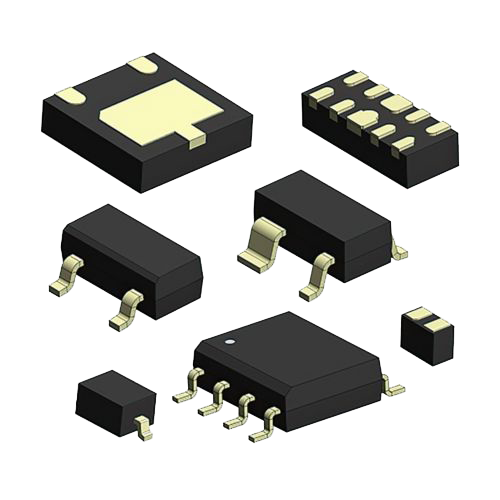
TVS Diodes Circuit Protection Electronics; https://www.eaton.com
TVS Diodes: A Closer Look
TVS diodes are the guardians of your electronic components. They protect against voltage transients, which are sneaky voltage surges that can pop up out of nowhere, thanks to things like electrostatic discharge (ESD), inductive load switching, and even lightning strikes. Voltage transients can do a real number on your circuits, damaging components like integrated circuits (ICs) and transistors by pushing them past their voltage limits.
The TVS diode saves the day by clamping down on the transient voltage, usually in just nanoseconds, and keeping your components safe. You can find these heroes in all kinds of configurations and applications, from your everyday gadgets to advanced aerospace systems.

A TVS diode symbol for unidirectional (top) and bidirectional (bottom) configurations.
Key Characteristics of TVS Diodes – The Specs that Matter
Breakdown Voltage (V_BR)
This is the voltage where the TVS diode starts to conduct serious current when it’s reverse-biased. It’s super important because it determines when the diode will start defending your circuit. TVS diodes come in all sorts of breakdown voltages, so you can find one that’s just right for your application.
Stand Off Voltage (V_WM)
Stand off voltage is the highest voltage where a TVS diode stays non-conducting during regular circuit operation. This spec is important, as it makes sure the diode doesn’t mess with the circuit’s normal behavior.
Clamping Voltage (V_C)
Think of the clamping voltage as the maximum voltage your components will see during a transient event. You want this to be lower than your components’ max voltage rating, but high enough to avoid false triggering.
Peak Pulse Current (I_PP)
This spec tells you the most current a TVS diode can handle during a transient event without getting damaged. The TVS diode you choose should have a peak pulse current rating higher than the max transient current you expect in your application.
Response Time
This is how long it takes for the TVS diode to go from chilling out to full-on protective mode when a transient event strikes. TVS diodes are lightning fast, making them great for protecting against sudden voltage surges.
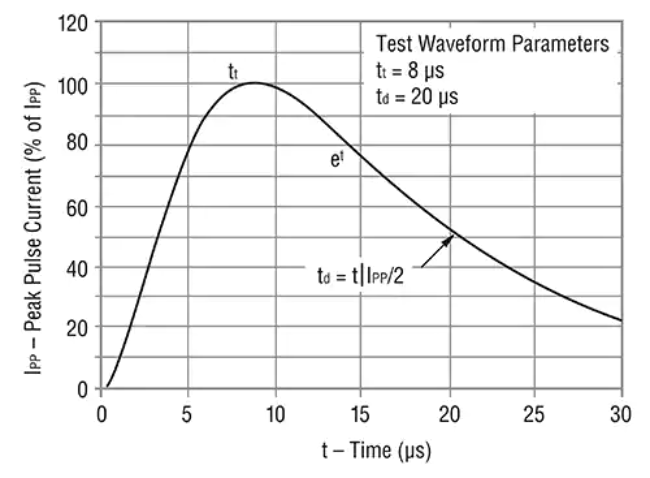
A graph illustrating the response time of a TVS diode; https:www.digikey.com
Capacitance
When dealing with high-frequency or high-speed signals, lower capacitance values reduce distortion but might compromise protection. So, always verify your application’s capacitance requirements and choose a TVS diode with an optimal value for maintaining signal integrity.
Unidirectional vs. Bidirectional TVS Diodes – Choose Your Guardian
TVS diodes are essential protectors for your circuits against positive and negative voltage events. However, the distinction between unidirectional and bidirectional TVS diodes is often misunderstood, leading to incorrect usage. Here, we’ll explore the characteristics of each type to help you make informed decisions when safeguarding your circuits.
Unidirectional TVS Diodes
Ideal for signals that remain positive with respect to ground, unidirectional TVS diodes are often the go-to choice for a majority of signals and protocols. Offering superior protection against negative events compared to bidirectional diodes, these should be your default selection for most signals, as illustrated in the chart below.
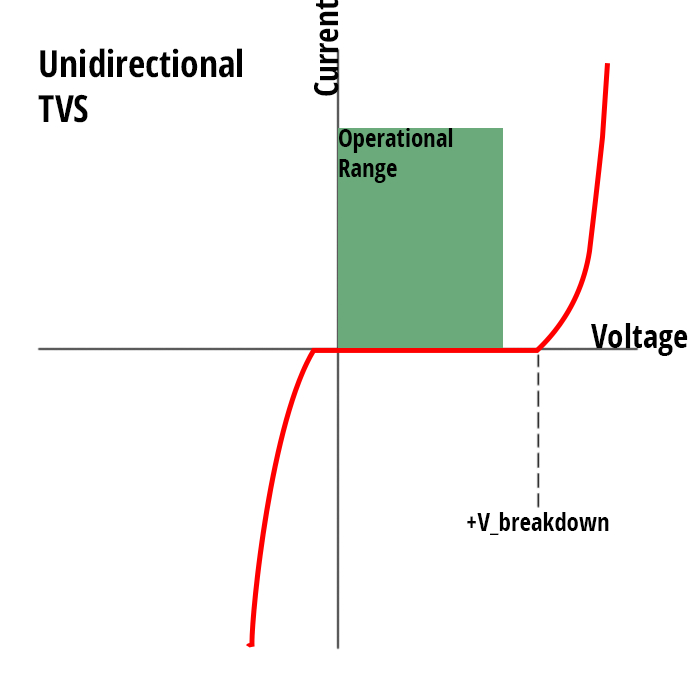
A unidirectional TVS protects a signal that is always positive with respect to ground.
Bidirectional TVS Diodes
Bidirectional TVS diodes consist of two TVS diodes in one package, prepared to clamp down on transient voltages of any polarity. Their application should be limited to cases where a signal exhibits both negative and positive characteristics. RS-485 based protocols serve as prime examples of such signals. Employing a bidirectional diode allows the signal to maintain its full range of common-mode voltage while still providing protection from voltage events in either polarity.
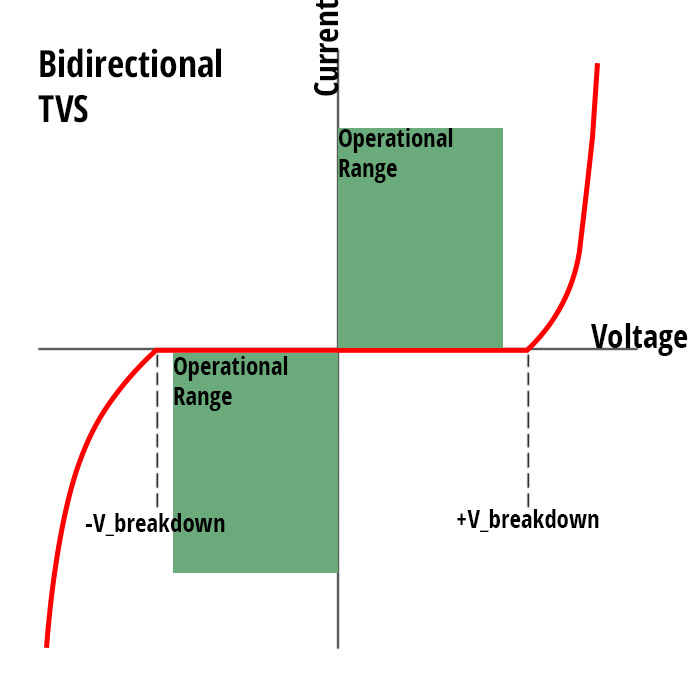
A bidirectional TVS protects a signal that swings from positive to negative with respect to ground.
Practical Considerations for Incorporating TVS Diodes in Circuit Design
Selecting the Perfect TVS Diode
When selecting a TVS diode for a particular application, it is crucial to consider the following parameters:
Breakdown voltage: Choose one slightly higher than your circuit’s normal operating voltage to avoid false triggering.
Stand Off Voltage: Pick one with a stand off voltage near or slightly above your circuit’s normal operating voltage, ensuring the diode intervenes only when needed.
Clamping voltage: Make sure it’s lower than your components’ max voltage rating.
Peak pulse current: Go for a TVS diode that can handle more current than you expect in your application.
Response time: Faster is better, so your diode can keep up with fast-rising voltage transients.
Capacitance: Take into account the capacitance requirements of your signal and choose a TVS diode that will maintain your high-frequency or high-speed signals with minimal distortion.

A table comparing different TVS diodes based on some key parameters; https:www.vishay.com
TVS Diode Placement – Location Matters
Placing your TVS diode correctly is crucial for effective protection. Keep it as close as possible to where the transient enters, like input terminals or connectors. This minimizes the inductive loop area and reduces the chance of secondary transient coupling.
Also, connect the diode in parallel with the component or line it’s protecting. In this setup, the TVS diode stays non-conducting under normal conditions and only conducts during a transient event, clamping the voltage across the protected component.
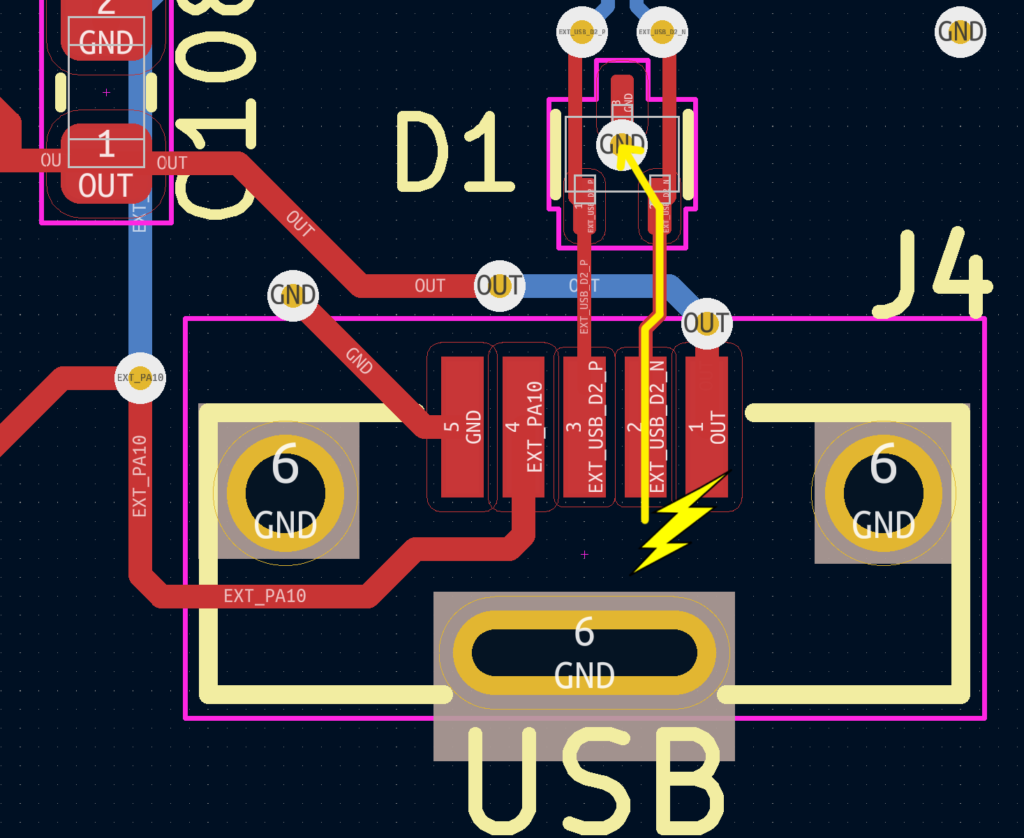
The physical placement of the TVS diodes should be as close as possible to the entrance point.
Grounding is Key
Good grounding is essential for your TVS diode to work its magic. You need a low-impedance ground connection to make sure the transient current gets directed away from your components and into the ground. Bad grounding can result in higher clamping voltages, slower response times, and reduced protection.
To get that low-impedance ground, use a ground plane or thick ground traces, and keep the trace length between the TVS diode and ground connection short. Avoid vias (when possible) or multiple layers in the ground path, as they can increase inductance and make your TVS diode less effective.
Conclusion
TVS diodes are circuit superheroes, protecting your electronics from voltage transients and ensuring they keep running smoothly. By getting to know their key characteristics, types, and practical considerations, you can make sure your sensitive components stay safe from voltage spikes. And don’t forget: proper selection, placement, and grounding are essential for optimal performance and long-lasting electronic devices.
So, remember to always think about your specific application and operating environment when choosing and using TVS diodes. Take your time to analyze your design needs and follow best practices for TVS diode implementation. This will help you create more robust and reliable electronic devices that can stand the test of time.


Thank you for a great write-up on tvs diodes Kyle.